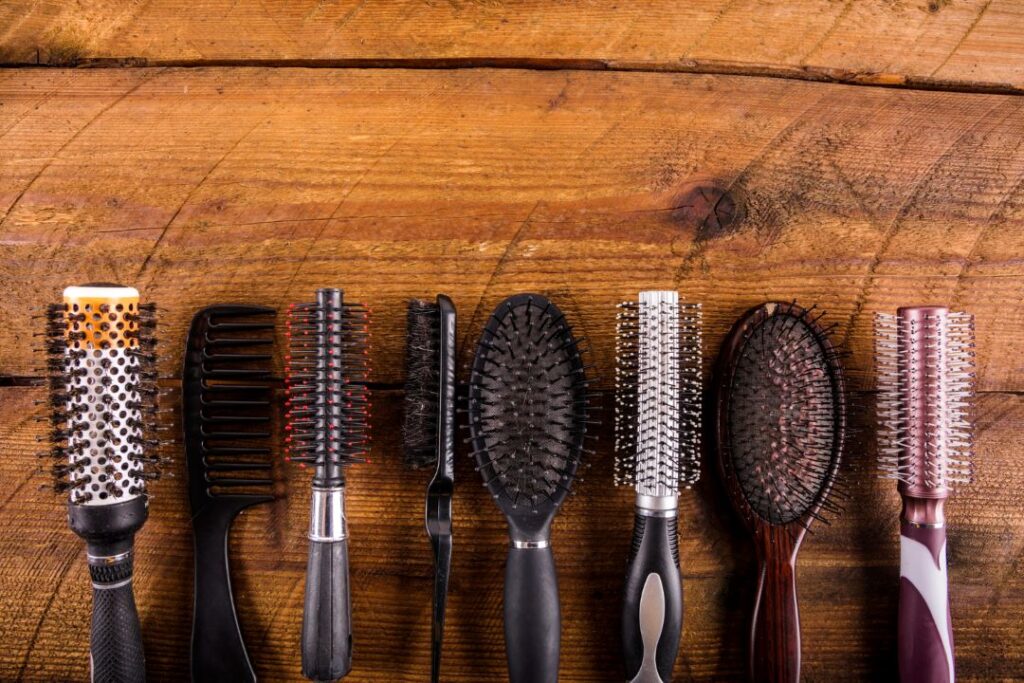Selecting the perfect hairbrush can make a significant difference in your hair’s health and appearance. At 504Salons, we believe that using the right hairbrush tailored to your hair type can transform your daily hair care routine. Whether you have fine, curly, or thick hair, finding the right brush is essential for maintaining beautiful, healthy locks. Here’s our comprehensive guide to help you choose the perfect hairbrush for your specific needs.
Understanding the Importance of the Right Hairbrush
Benefits of Using the Right Hairbrush
Using the right hairbrush can prevent breakage, reduce frizz, and promote a healthy scalp. It can also make styling easier and more efficient. By choosing a brush that suits your hair type, you can enhance your hair’s natural beauty and maintain its health.
Different Types of Hairbrushes
There are various types of hairbrushes, each designed to serve a specific purpose. Understanding these can help you make an informed decision:
- Paddle Brushes: Great for detangling and smoothing hair, especially for those with straight or wavy hair.
- Round Brushes: Ideal for blow-drying and creating volume or curls. Perfect for all hair types, depending on the barrel size.
- Vent Brushes: Designed for faster drying with blow-dryers, these are excellent for fine to medium hair.
- Boar Bristle Brushes: Best for distributing natural oils from the scalp, suitable for all hair types, particularly fine and damaged hair.
- Wide-Tooth Combs: Essential for detangling wet hair without causing breakage, ideal for curly and thick hair.
Choosing the Right Hairbrush for Your Hair Type
Fine Hair
For fine hair, a boar bristle brush is a great option. It helps distribute natural oils evenly, adding shine and reducing the need for excessive washing. Additionally, a paddle brush can gently detangle without causing damage.
Curly Hair
Curly hair benefits from wide-tooth combs and brushes with flexible bristles. These tools help detangle without breaking the curls. A vent brush can also be useful for quick drying and adding volume to curls.
Thick Hair
For thick hair, a paddle brush with strong bristles is ideal. It can handle the density of thick hair and help in detangling. A round brush with a large barrel can also be beneficial for styling and adding volume.
Damaged Hair
If you have damaged hair, consider using a soft-bristle brush or a wide-tooth comb to minimize further breakage. Avoid brushes with hard or stiff bristles that can cause more damage.
Tips for Maintaining Your Hairbrush
Regular Cleaning
Cleaning your hairbrush regularly is essential for maintaining its effectiveness and hygiene. Remove hair from the bristles after each use and wash the brush with warm water and mild shampoo weekly.
Proper Storage
Store your hairbrush in a clean, dry place to prevent the growth of bacteria and mold. Avoid leaving it in damp areas like the bathroom.
Conclusion
Choosing the right hairbrush is crucial for maintaining healthy, beautiful hair. By selecting a brush tailored to your hair type, you can enhance your hair’s natural beauty and keep it in excellent condition. At 504Salons in Irving and Euless, we offer personalized advice and a range of hairbrushes to suit every need. Visit us today to find the perfect hairbrush and get expert tips on hair care.
FAQs
Q1: How often should I clean my hairbrush?
A1: You should clean your hairbrush at least once a week. Regular cleaning prevents product buildup, oils, and dirt from accumulating on the bristles. Start by removing any hair caught in the brush. Then, soak the brush in warm water mixed with a bit of shampoo or baking soda. Use an old toothbrush to scrub between the bristles, rinse thoroughly, and let it air dry. Regular maintenance keeps your hairbrush effective and extends its lifespan.
Q2: Can using the wrong hairbrush damage my hair?
A2: Yes, using the wrong hairbrush can cause significant damage to your hair. For example, a brush with stiff bristles can lead to breakage and split ends, especially on fine or damaged hair. Similarly, using a narrow-toothed comb on curly hair can disrupt curl patterns and cause frizz. It’s crucial to select a hairbrush that suits your hair type and texture to maintain hair health and prevent unnecessary damage.
Q3: What type of hairbrush is best for blow-drying?
A3: Round brushes are ideal for blow-drying as they help create volume and shape. The size of the barrel should match your hair length and the desired style; smaller barrels are perfect for creating curls or waves, while larger barrels add volume and smoothness. Additionally, vent brushes are beneficial for faster drying since they allow air to flow through, reducing drying time and minimizing heat damage.
Q4: Are boar bristle brushes good for all hair types?
A4: Boar bristle brushes are excellent for most hair types, particularly fine and damaged hair. They distribute natural oils from the scalp along the hair shaft, adding shine and reducing the need for additional styling products. However, for very curly or thick hair, it’s often better to use a combination of a boar bristle brush and a wide-tooth comb or paddle brush to manage tangles and maintain the integrity of the hair.
Q5: How do I choose the right hairbrush for curly hair?
A5: For curly hair, wide-tooth combs and brushes with flexible bristles are ideal. These tools help detangle hair without breaking the curls. Look for brushes specifically designed for curly hair, such as those with spaced-out bristles to gently separate curls. Additionally, using a vent brush can aid in quicker drying times while maintaining volume. Always detangle curly hair when it’s wet and coated with conditioner to minimize breakage and frizz.
